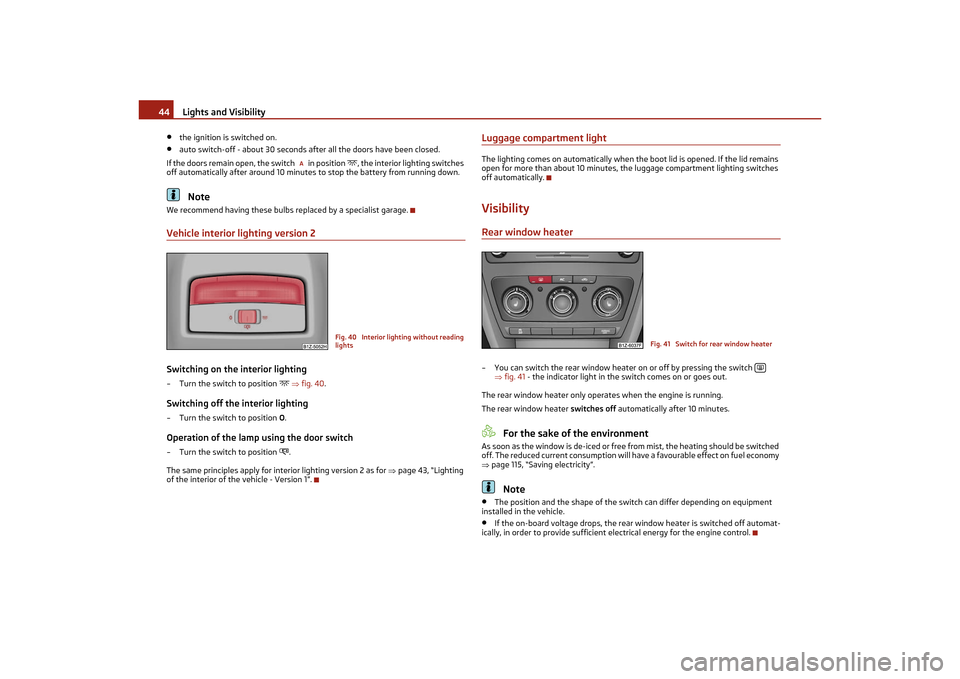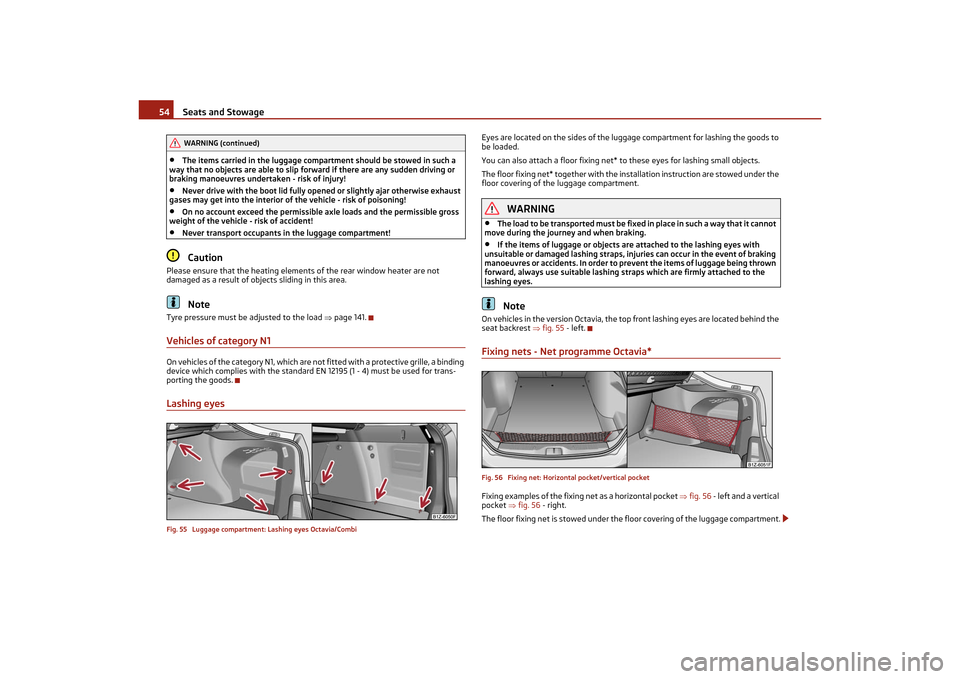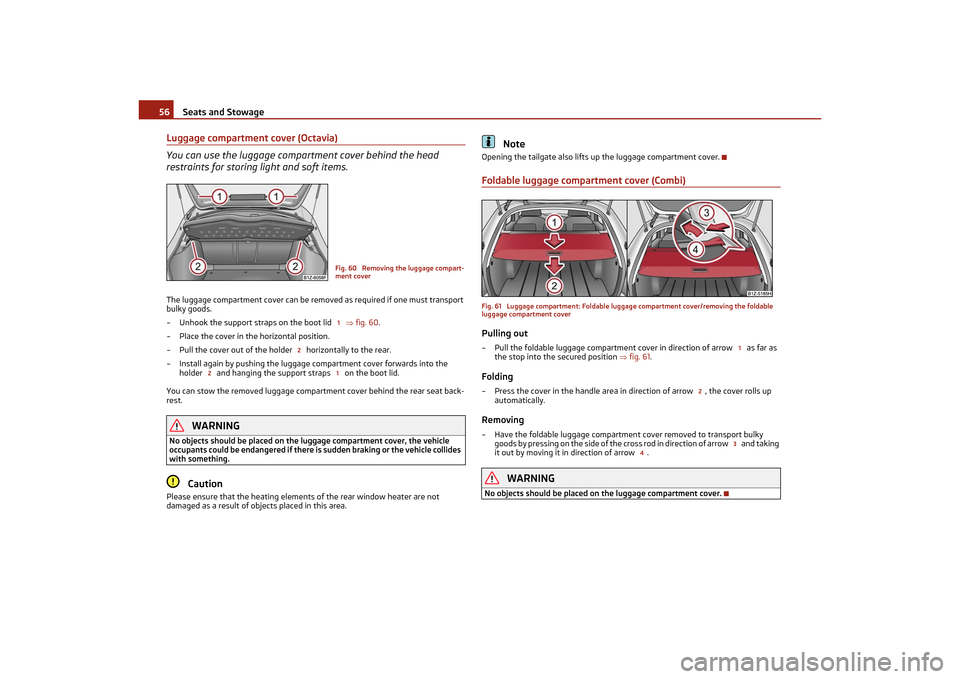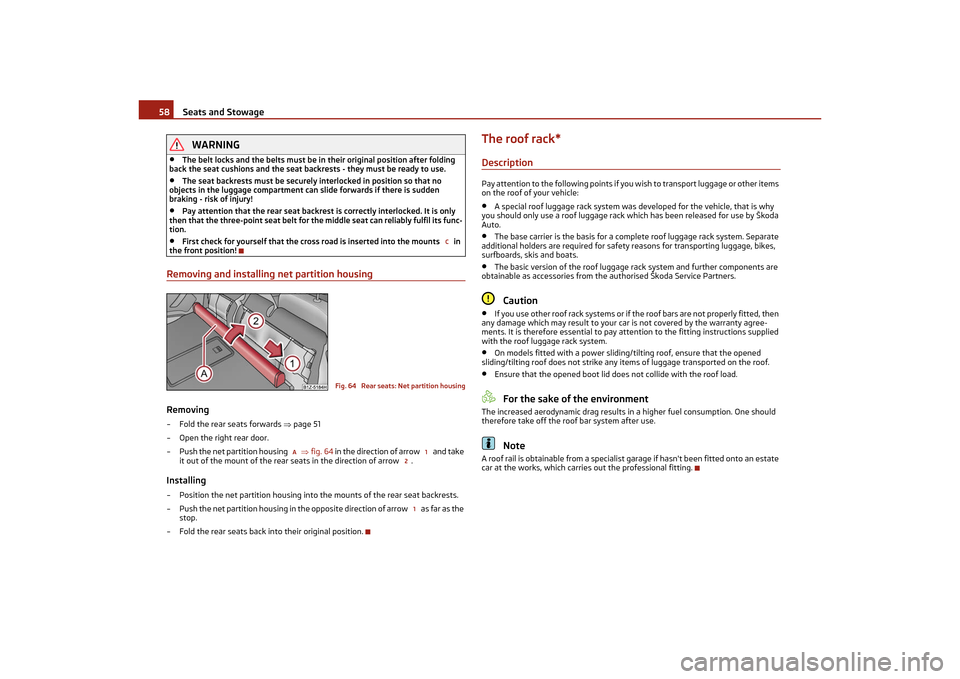2011 SKODA OCTAVIA TOUR boot
[x] Cancel search: bootPage 36 of 183

Unlocking and locking35
Using the system
Safety
Driving Tips
General Maintenance
Breakdown assistance
Technical Data
If a lost key is replaced or if the receiver unit has been repaired or a new unit
installed, it is then necessary for an auth
orised Škoda Service Partner to initialise
the system. Only after this is it poss ible to again use the remote control.
Note
•
The remote control is automatically deactivated when the ignition is switched
on.
•
The operation of the remote control may temporarily be affected by interfer-
ence from transmitters close to the car and which operate in the same frequency
range (e.g. mobile phone, TV transmitter).
•
The battery must be replaced, ideally by an authorised Škoda Service Partner, if
the central locking or anti-theft alarm syst em does react to the remote control at
less than 3 metres away.
•
If the driver door is opened, the vehicle cannot be locked using the remote
control.
Unlocking and locking the vehicleUnlocking the vehicle
– Press the button fig. 30 for about 1 second.Locking the vehicle
– Press button for about 1 second.Deactivating safe securing system– Press button twice in 2 seconds. Further information page 31.
Boot lid remote release
– Press button for about 2 second. Further information page 33.Folding out of the key–Press button .Folding up of the key– Press button and collapse the key bit in the housing.
The turn signal lights flash twice as confirmation that the vehicle has been
unlocked. The vehicle will lock again automatically if you unlock the vehicle using
button but do not open a door or the b oot lid within the next 30 seconds. This
function is intended to prevent th e car being unlocked unintentionally.
Display of the locking
The turn signal lights flash once to co nfirm that the vehicle has been correctly
locked.
If the vehicle is locked by pressing the button and some doors or the boot lid are
not closed, the turn signal li ghts flash only after closing.
WARNING
If the vehicle is locked from the outsid e and the safe securing system is acti-
vated, there must not be any person in th e vehicle as it is then not possible to
open either a door or a window from the inside. The locked doors make it more
difficult for rescuers to get into the vehicle in an emergency - hazard!
Note
•
Operate the radio remote control only when the doors and boot lid are closed
and you have visual contact with the vehicle.
•
Once in the car, you must not press the lock button
of the radio remote control
before inserting the key into the ignition lock in order to avoid the car being inad-
vertently locked and the alarm system* being switched on. Should this happen,
press the unlock button
of the radio remote control.
Synchronisation of the remote controlIf the vehicle cannot be unlocked by actuating the remote control system then it is
possible that the code in the key and the control unit in the vehicle are no longer
Fig. 30 Remote control key
1
33
244
1
3
s2lk.2.book Page 35 Monday, April 18, 2011 7:41 AM
Page 37 of 183

Unlocking and locking
36
synchronised. This can occur when the butt ons on the radio-operated key are actu-
ated a number of times outside of the operative range of the equipment or the
battery on the remote control was replaced.
This means it is necessary to synchronise the code as follows:•
Press any button on the remote control.
•
pressing of the button means that the door will unlock with the key within 1
minute.
Anti-theft alarm system*DescriptionThe anti-theft alarm system increases the level of protection against people
seeking to break into the vehicle. The system triggers audible and visual warning
signals if an attempt is made to break into the vehicle.
How is the alarm system activated?
The anti-theft alarm system is activated automatically when the vehicle is locked
with the key on the closed dr iver's door or by using the radio remote control. It is
activated 30 seconds after locking the door.
How is the alarm system deactivated?
The anti-theft alarm system is deactivated if the vehicle is unlocked by only using
the radio remote control. The vehicle is automatically locked again if the vehicle is
not opened within 30 seconds after re activating the anti-theft alarm system.
Once you unlock the vehicle by inserting th e key into the driver door you then have
to insert the key into the ignition lock and switch the ignition on within 15 seconds
after opening the door in order to deactivate the anti-theft alarm system. The alarm
will be triggered if you do not switch on the ignition within 15 seconds.
When is the alarm triggered?
The following security areas of the locked vehicle are monitored:•
Bonnet,
•
Boot lid,
•
Doors,
•
Ignition lock,
•
vehicle's angle of inclination page 36, “Interior monitor* and Towing protec-
tion monitoring*”,
•
Vehicle interior page 36, “Interior monitor* and Towing protection moni-
toring*”,
•
A drop in voltage of the on-board power supply.
An alarm is immediately triggered if either of the two battery terminals is discon-
nected while the anti-theft alarm system is activated.
How is the alarm switched off?
You switch the alarm off if you unlock the vehicle with the radio remote control or
if you switch the ignition on.Note
•
The working life of the alarm siren is 6 ye ars. More detailed information is avail-
able by a specialist garage.
•
Before leaving the vehicle, check that all the doors and windows are closed in
order to ensure that the anti-theft alarm system is fully operational.
•
Coding of the radio remote control and th e receiver unit precludes the use of the
radio remote control from other vehicles.
Interior monitor* and Towi ng protection monitoring*Switch off the interior monitor and towing protection monitoring– Switch off the ignition.
– Open the driver door.
– Press the button
at the centre column on the driver side fig. 31, the
symbol
which lights up in the button changes from red to orange.
– Lock the vehicle within 30 seconds.
Fig. 31 Button for interior monitor and
towing protection monitoring
s2lk.2.book Page 36 Monday, April 18, 2011 7:41 AM
Page 45 of 183

Lights and Visibility
44
•
the ignition is switched on.
•
auto switch-off - about 30 seconds after all the doors have been closed.
If the doors remain open, the switch in position
, the interior lighting switches
off automatically after around 10 minutes to stop the battery from running down.
Note
We recommend having these bulbs replaced by a specialist garage.Vehicle interior lighting version 2Switching on the interior lighting– Turn the switch to position
fig. 40 .
Switching off the interior lighting– Turn the switch to position O.Operation of the lamp using the door switch– Turn the switch to position
.
The same principles apply for interior lighting version 2 as for page 43, “Lighting
of the interior of the vehicle - Version 1”.
Luggage compartment lightThe lighting comes on automatically when the boot lid is opened. If the lid remains
open for more than about 10 minutes, th e luggage compartment lighting switches
off automatically.VisibilityRear window heater– You can switch the rear window heater on or off by pressing the switch
fig. 41 - the indicator light in the switch comes on or goes out.
The rear window heater only operates when the engine is running.
The rear window heater switches off automatically after 10 minutes.
For the sake of the environment
As soon as the window is de-iced or free from mist, the heating should be switched
off. The reduced current consumption will ha ve a favourable effect on fuel economy
page 115, “Saving electricity”.
Note
•
The position and the shape of the switch can differ depending on equipment
installed in the vehicle.
•
If the on-board voltage drop s, the rear window heater is switched off automat-
ically, in order to provide sufficient electrical energy for the engine control.
A
Fig. 40 Interior lighting without reading
lights
Fig. 41 Switch for rear window heater
s2lk.2.book Page 44 Monday, April 18, 2011 7:41 AM
Page 55 of 183

Seats and Stowage
54
•
The items carried in the luggage compartment should be stowed in such a
way that no objects are able to slip fo rward if there are any sudden driving or
braking manoeuvres undert aken - risk of injury!
•
Never drive with the boot lid fully opened or slightly ajar otherwise exhaust
gases may get into the interior of the vehicle - risk of poisoning!
•
On no account exceed the permissible axle loads and the permissible gross
weight of the vehicle - risk of accident!
•
Never transport occupants in the luggage compartment!Caution
Please ensure that the heating elements of the rear window heater are not
damaged as a result of objects sliding in this area.
Note
Tyre pressure must be adjusted to the load page 141.Vehicles of category N1On vehicles of the category N1, which are no t fitted with a protective grille, a binding
device which complies with the standard EN 12195 (1 - 4) must be used for trans-
porting the goods.Lashing eyesFig. 55 Luggage compartment: Lashing eyes Octavia/Combi
Eyes are located on the sides of the lugg age compartment for lashing the goods to
be loaded.
You can also attach a floor fixing net* to these eyes for lashing small objects.
The floor fixing net* together with the in stallation instruction are stowed under the
floor covering of the luggage compartment.
WARNING
•
The load to be transported must be fixe d in place in such a way that it cannot
move during the jour ney and when braking.
•
If the items of luggage or objects ar e attached to the lashing eyes with
unsuitable or damaged lashing straps, injuries can occur in the event of braking
manoeuvres or accidents. In order to pr event the items of luggage being thrown
forward, always use suitable lashing st raps which are firmly attached to the
lashing eyes.Note
On vehicles in the version Octavia, the to p front lashing eyes are located behind the
seat backrest fig. 55 - left.Fixing nets - Net programme Octavia*Fig. 56 Fixing net: Horizontal pocket/vertical pocketFixing examples of the fixing net as a horizontal pocket fig. 56 - left and a vertical
pocket fig. 56 - right.
The floor fixing net is stowed under the floor covering of the luggage compartment.
WARNING (continued)
s2lk.2.book Page 54 Monday, April 18, 2011 7:41 AM
Page 56 of 183

Seats and Stowage55
Using the system
Safety
Driving Tips
General Maintenance
Breakdown assistance
Technical Data
WARNING
The whole strength of the net makes it possible to load the pocket with objects
of up to 1.5 kg in weight. Heavy objects ar e not secured sufficiently - risk of injury
and net damage!
Caution
Do not place any objects with sharp edges in the nets - risk of net damage.Fixing nets - Ne t programme Combi*Fig. 57 Fixing net: Vertical pocket /division of the luggage compartmentFixing examples of the fixing net as pocket fig. 57 - left and as division of the
luggage compartment fig. 57 -right.
The floor fixing net is stowed under the floor covering of the luggage compartment.
WARNING
The whole strength of the net makes it possible to load the pocket with objects
of up to 1.5 kg in weight. Heavy objects ar e not secured sufficiently - risk of injury
and net damage!
Caution
Do not place any objects with sharp edges in the nets - risk of net damage.
Folding hooks (Combi)Folding hooks for attaching small items of lu ggage, such as bags etc., are provided
on both sides of the luggage compartment fig. 58 .
An item of luggage weighing up to 10 kg can be attached to the hook.Fixing floor covering of the luggage compartmentFig. 59 Luggage compartment: Fixing of the floor covering Octavia/CombiThere is a loop (Octavia) or there are hook s (Combi) located on the floor covering of
the luggage compartment. You can fix the raised floor cover with a hook to the
luggage compartment cover (Octavia) fig. 59 - left, as if one needs to reach the
spare wheel or to the frame of the boot lid (Combi) fig. 59 - right.
Fig. 58 Luggage compartment: folding
hooks
s2lk.2.book Page 55 Monday, April 18, 2011 7:41 AM
Page 57 of 183

Seats and Stowage
56
Luggage compartment cover (Octavia)
You can use the luggage compartment cover behind the head
restraints for storing light and soft items.The luggage compartment cover can be removed as required if one must transport
bulky goods.
– Unhook the support straps on the boot lid fig. 60 .
– Place the cover in the horizontal position.
– Pull the cover out of the holder horizontally to the rear.
– Install again by pushing the luggage compartment cover forwards into the
holder and hanging the suppor t straps on the boot lid.
You can stow the removed luggage compartment cover behind the rear seat back-
rest.
WARNING
No objects should be placed on the luggage compartment cover, the vehicle
occupants could be endangered if there is sudden braking or the vehicle collides
with something.
Caution
Please ensure that the heating elements of the rear window heater are not
damaged as a result of objects placed in this area.
Note
Opening the tailgate also lifts up the luggage compartment cover.Foldable luggage compartment cover (Combi)Fig. 61 Luggage compartment: Foldable lugg age compartment cover/removing the foldable
luggage compartment coverPulling out– Pull the foldable luggage compartment cover in direction of arrow as far as the stop into the secured position fig. 61 .Folding– Press the cover in the handle area in direction of arrow , the cover rolls up
automatically.Removing– Have the foldable luggage compartment cover removed to transport bulky
goods by pressing on the side of the cros s rod in direction of arrow and taking
it out by moving it in direction of arrow .
WARNING
No objects should be placed on the luggage compartment cover.
Fig. 60 Removing the luggage compart-
ment cover1
2
2
1
1
2
3
4
s2lk.2.book Page 56 Monday, April 18, 2011 7:41 AM
Page 59 of 183

Seats and Stowage
58WARNING
•
The belt locks and the belts must be in their original position after folding
back the seat cushions and the seat backrests - they must be ready to use.
•
The seat backrests must be securely interlocked in position so that no
objects in the luggage compartment can slide forwards if there is sudden
braking - risk of injury!
•
Pay attention that the rear seat backrest is correctly interlocked. It is only
then that the three-point seat belt for the middle seat can reliably fulfil its func-
tion.
•
First check for yourself that the cross road is inserted into the mounts in
the front position!
Removing and installing net partition housingRemoving– Fold the rear seats forwards page 51
– Open the right rear door.
– Push the net partition housing fig. 64 in the direction of arrow and take
it out of the mount of the rear seats in the direction of arrow .Installing– Position the net partition housing into the mounts of the rear seat backrests.
– Push the net partition housing in the opposite direction of arrow as far as the stop.
– Fold the rear seats back in to their original position.
The roof rack*DescriptionPay attention to the following points if you wish to transport luggage or other items
on the roof of your vehicle:•
A special roof luggage rack system was developed for the vehicle, that is why
you should only use a roof luggage rack which has been released for use by Škoda
Auto.
•
The base carrier is the basis for a complete roof luggage rack system. Separate
additional holders are required for safety reasons for transporting luggage, bikes,
surfboards, skis and boats.
•
The basic version of the roof luggage ra ck system and further components are
obtainable as accessories from the authorised Škoda Service Partners.Caution
•
If you use other roof rack systems or if th e roof bars are not properly fitted, then
any damage which may result to your car is not covered by the warranty agree-
ments. It is therefore essential to pay atte ntion to the fitting instructions supplied
with the roof luggage rack system.
•
On models fitted with a power sliding/tilting roof, ensure that the opened
sliding/tilting roof does not strike any items of luggage transported on the roof.
•
Ensure that the opened boot lid do es not collide with the roof load.For the sake of the environment
The increased aerodynamic drag results in a higher fuel consumption. One should
therefore take off the roof bar system after use.
Note
A roof rail is obtainable from a specialist garage if hasn't been fitted onto an estate
car at the works, which carries out the professional fitting.
C
Fig. 64 Rear seats: Net partition housing
A
1
21
s2lk.2.book Page 58 Monday, April 18, 2011 7:41 AM
Page 125 of 183

Taking care of your vehicle and cleaning the vehicle
124Caution
Never wipe the headlights dry and do not use any sharp objects for cleaning the
plastic lenses, this may result in damage to the protective paintwork and conse-
quently in formation of cracks on the head light lenses, e.g. through effect of chem-
ical products.Door and window sealsThe rubber seals on the doors, boot lid, bonnet and windows remain supple and last
longer if you treat them from time to ti me with a rubber care product (e.g. with a
spray with silicone-free oil). You also avoi d premature wear of the seals and prevent
leakages in this way. It is also easier to open the doors. Rubber seals which are well
cared for also do not stick together in cold winter weather.Locking cylinderWe recommend that you use the spray from Škoda original accessories with
regreasing and anticorrosive effect for de-icing locking cylinders.
Note
When washing your vehicle, ensure that as little water as possible gets into the
locking cylinders.WheelsSteel wheels
You should also thoroughly wash the wheels and wheel trims when giving your
vehicle its regular wash. This prevents any brake dust, dirt and road salt from
sticking to the wheel hubs. You can remove stubborn brake abrasion adhering to
the wheels with an industrial cleaner. Touch up any damage to the paintwork on the
wheels before rust is able to form.
Light alloy wheels
Regular care of light alloy wheels is nece ssary in order to retain their decorative
appearance over long periods. It is part icularly important to remove regularly any
road salt and brake abrasion from light alloy wheels, otherwise the light metal will
suffer. Wash thoroughly and then treat the wheels with a protective product for
light alloy wheels which does not contai n any acidic components. We recommend
to apply a hard wax layer onto the wheel hubs every three months. You must not use any products which cause abrasion when treating the wheel hubs. Any damage
to the paint layer on the wheel hubs must be touched up immediately.
We recommend using a preservative from
Škoda genuine accessories offered by
your Škoda dealer.
WARNING
One should remember when cleaning the wh eels that moisture, ice and road salt
may adversely affect braking efficiency - risk of an accident!
Note
Severe layers of dirt on the wheels can also result in wheel imbalance. This may
show itself in the form of a wheel vibrat ion which is transmitted to the steering
wheel which, in certain circumstances, can cause premature wear of the steering.
This means it is necessary to remove the dirt.Underbody protectionThe underside of your vehicle is protected for life against chemical and mechanical
influences.
One cannot, however, completely rule out damage to the protective layer when
driving so we recommend that you inspect the protective layer on the underside of
your vehicle and on the chassi s at certain intervals - this is best done at the begin-
ning and end of the winter - and to touch up any damaged areas.
The authorised Škoda Service Partners have suitable spray products available as
well as the necessary equipment and are famili ar with the instructions for use. It is
therefore best to have such touch-up work or additional corrosion protection meas-
ures carried out by an authorised Škoda Service Partner.
WARNING
Never use additional underbody protection or corrosion-protection agents for
the exhaust pipes, catalytic converters or heat shields. When the engine reaches
its operating temperature, these subst ances might ignite - risk of fire!Protection of hollow spacesAll the cavities of your vehicle which are at risk from corrosion are protected for life
by a layer of protective wax applied in the factory.
s2lk.2.book Page 124 Monday, April 18, 2011 7:41 AM